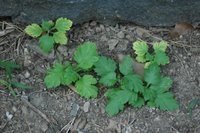... Of the two and a half million animals so far described considerably less than 60,000 fall into the sub-phylum Vertebrata [the spined] - that is, less than three percent of described animals build their bodies in the same way we do. Even that number is a great under-estimation; there are probably at least 10 million arthropods and very few vertebrates not yet known to man. ...So, fellow gardeners, when you're feeling outnumbered by the beasties in your garden, you are.
Your host got picked up for this issue:
More beetle news from Xris of Flatbush Gardener who reports that the state of New York has decided to change the state insect to one that actually lives in the state of New York.Even cooler, several of my favorite bloggers are also in this issue, including:
- Bev at Burning Silo steals the show with The surprise behind an Io Moth's forewings, from the water into the air, fireflies in action, eggs under a leaf and the hatchlings, and a strange chimera. She's got the best "bugs", and the most magnificent macrophotography of them.
- A slightly anticlimactic series of photos from Wayne at Niches.
- Owlet Butterflies from Carel's Rigor Vitae.
- Bobtail squid, pop-culture squids and a giant octopus from PZ Myer's Pharyngula.
- Drosophila melanogaster body clock gene and daily rhythms in Cnidaria from Coturnix.
- Image of carnivorous shrimp captured by a submersible and Washington State deep-water corals from Peter Etnoyer's Deep Sea News.






